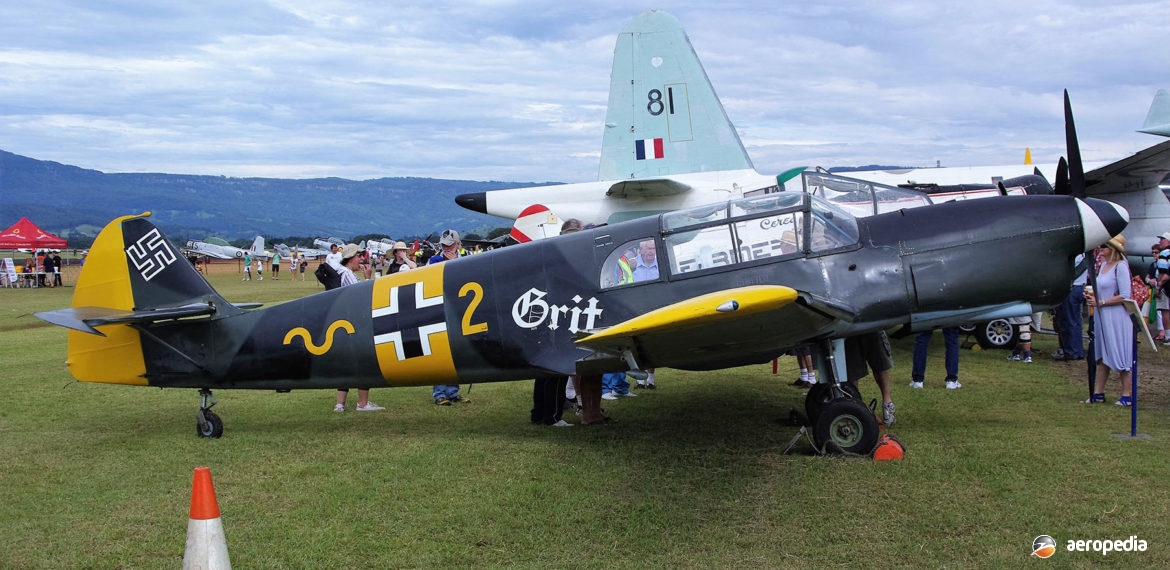Photograph:
Nord 1002 Pingouin VH-OFS (c/n 285) painted in Luftwaffe markings at Albion Park, NSW (David C Eyre)
Country of origin:
France
Description:
Four-seat military trainer and communications aircraft
Power Plant:
One 174 kw (233 hp) Renault 6Q 10 six-cylinder in-line air-cooled engine
Specifications:
- Wingspan: 10.51 m (34 ft 5 in)
- Length: 8.55 m (28 ft 1 in)
- Height: 2.31 m (7 ft 6½ in)
- Wing area: 16.46 m² (172.22 sq ft)
- Max speed at 1,000 m (3,280 ft): 298 km/h (185 mph)
- Max cruising speed at 1,500 m (4,920 ft): 269 km/h (167 mph)
- Stalling speed, clean: 80 km/h (50 mph)
- Stalling speed with flaps and undercarriage down: 69 km/h (43 mph)
- Take-off run: 183 m (600 ft)
- Landing run: 131 m (430 ft)
- Service ceiling: 5,974 m (19,600 ft)
- Range: 850 km (528 miles)
- Empty weight: 898 kg (1,980 lb)
- Loaded weight: 1,483 kg (3,270 lb)
History:
The Nord 1002 Pingouin devolved from the Messerschmitt Bf 108 (see separate article). Following the invasion of France, a decision was made by the German RLM (State Ministry of Aviation) to transfer production to the SNCA de Nord facility at Les Mureaux to free up production facilities in Germany for fighter production. Production of the type continued throughout the war, 50 being built in 1942, 108 in 1943, and 12 in 1944 before France was liberated by Allied forces. These aircraft were fitted with the German Argus V-8 engine, as was the Messerschmitt Bf 108, but in 1945, after the Armistice, production continued for the French Air Force as the Nord 1002 Pingouin, these being fitted with a 174 kw (233 hp) Renault 6Q-10 or 6Q-11 in-line engine, some 285 being completed. Further variants were the Nord 1003 with a 179 kw (240 hp) Potez 6D engine, and the Nord 1004 with a 228 kw (305 hp) engine.
Whereas the Bf 108 was a three-seater, the Nord aircraft, the Renault engine of which rotated clockwise in lieu of anti-clockwise of the Argus, was a four-seater. Most production aircraft were delivered to the French armed services for liaison and communication duties. After retirement a number of examples were made available on the civil aircraft market and saw service as private aircraft due to their good performance, with at least 45 being registered in France. Also, as they were a development of the Messerschmitt Bf 108 series, many were painted in Luftwaffe markings and operated as warbirds.
In May 1937 a Bf 108B (c/n 992) was obtained by Guinea Airways of Adelaide, SA, being issued with Certificate of Registration 645 on 24 May 1937. It was powered by a 183 kw (245 hp) Argus 10C engine. It saw service with that company as VH-UZI until it was exported to the Netherlands East Indies on 18 March 1940. It was shipped to Surabaya but it was destroyed when it crashed into a mountain in 1942.
In 1990 a Nord 1002 fitted with a Renault engine was imported to Bankstown, NSW. Painted in World War II Luftwaffe Messerschmitt Bf 109 markings it required some restoration. Registration VH-HUN² (c/n 285 – ex C-GRIT, N108R, OO-GVD, F-BGVD) was reserved but not taken up and later it became VH-OFS. Soon after restoration it was damaged in a forced landing and had to undergo further repairs. It was eventually conveyed to the Historic Aircraft Restoration Society hangars at Albion Park, NSW, where it underwent restoration. In mid-2019 it was sold and exported to Omaka, NZ for further restoration to airworthiness. In the meantime it was placed on display at the Omaka Heritage Centre.
In 1996 another Nord 1002 was imported for Fighter Trainers of Auckland, NZ and this aircraft (c/n 103) became ZK-WFI. This machine had an interesting history: originally built in Germany in 1943 as a Bf 108 Taifun, it was shot down and is reported to have crashed twice during its early life, being rebuilt by Nord in 1945. For reliability at some stage it was fitted with a Lycoming engine.

